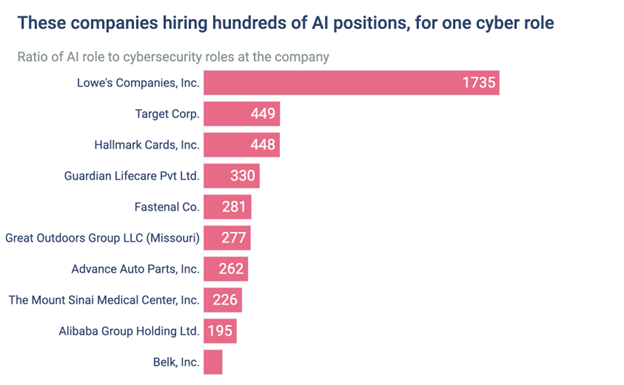Executive Summary
● The demand for both AI and advanced cybersecurity talent has shown a robust and parallel increase, underlining the integral role these positions play in maintaining and securing advanced digital infrastructures.
● Companies exhibiting the highest ratios of cybersecurity to AI roles are predominantly found in sectors such as financial services, healthcare, and consulting. This pattern underscores a deliberate, proactive security-first strategy that is essential for mitigating the risks posed by sophisticated AI technologies. The emphasis on cybersecurity in these sectors reflects their heightened need for data security and stringent regulatory compliance
● Conversely, analysis reveals that companies with the highest ratios of AI to cybersecurity roles are predominantly in the retail sector.
● The salary data reveals a close parity between mid-level cybersecurity roles and AI engineering positions, with only a slight edge in compensation for AI roles, emphasizing the competitive value and demand for expertise in both fields.
Introduction to the AI Cybersecurity Revolution
In the rapidly evolving landscape of cybersecurity, the adoption of advanced artificial intelligence technologies is reshaping the threats and challenges stakeholders face. As organizations increasingly rely on digital infrastructures, the sophistication and frequency of cyber threats have escalated, prompting a shift towards more dynamic and intelligent security solutions. AI is at the forefront of this transformation, offering unprecedented capabilities in understanding and anticipating cyber threats.
However, this shift also introduces new vulnerabilities as reliance on AI can create complex, opaque systems that might be exploited. This evolving scenario necessitates a re-evaluation of traditional security paradigms and a deeper understanding of AI’s dual role as both a tool and a potential target within the cyber domain.
AI’s integration into the cyber domain is revolutionizing how organizations approach threat prevention, detection, response, and recovery. By leveraging machine learning algorithms and data analytics, AI enhances the ability to identify patterns and anomalies that indicate potential security threats. This proactive approach not only speeds up the detection process but also improves the accuracy of identifying real threats among false alarms. Furthermore, AI-driven automation supports cybersecurity teams by handling routine tasks and responding to incidents with a speed and precision that human operators cannot match. This not only optimizes resource allocation but also allows human talent to focus on more strategic, high-level operations.
AI Cybersecurity Risks and Talent Needs
Despite these advancements, the integration of AI into cybersecurity workflows presents significant challenges, particularly in the area of talent development and management. There is a growing need for professionals who not only understand cybersecurity at a technical level but are also proficient in AI and machine learning. The industry faces a talent gap, with a shortage of skilled professionals equipped to manage and oversee AI-driven security systems. The rise of AI is transforming the cybersecurity landscape, highlighting the opportunities and challenges it presents, and emphasizing the critical need for a new generation of cybersecurity professionals who are as adept with AI as they are with traditional security measures.
Demand for Cybersecurity Jobs & AI Jobs
This analysis of job market trends for cybersecurity and AI-related positions in the United States over the last 14 years, based on job postings data from Revelio Labs, shows a consistent and parallel rise in demand for both fields. Cybersecurity roles have notably sustained a higher demand than AI roles, emphasizing their essential role in protecting digital assets. A significant spike in job postings across both sectors in 2022 marks a key evolutionary point in the industry.
Integration of AI in Cybersecurity Strategies
Over more than a decade, this trend has illustrated the growing interdependencies between AI and cybersecurity. As AI technologies advance and become more prevalent, the competencies required for cybersecurity positions have expanded to include AI skills. This shift reflects an industry-wide acknowledgment that effective cybersecurity strategies increasingly depend on the integration of sophisticated AI tools to effectively manage and mitigate threats.
The continued growth in both fields underscores the necessity for a strategic approach to workforce development. The persistent high demand for cybersecurity professionals indicates an ongoing need for traditional security skills, which is now augmented by a growing requirement for AI expertise within these roles. This scenario calls for a thorough reassessment of educational programs and professional training to ensure that candidates develop a comprehensive skill set that span both cybersecurity and AI. Such data-driven insights are crucial for shaping future educational and workforce development strategies to address the intricate demands of today’s digital landscape.

Security-First Approach in the AI-Driven Era
Cybersecurity-Tracking AI Demand
Analyzing companies with the highest ratios of cybersecurity to AI roles vividly illustrates their strategic focus on security as their engagement with AI technologies intensifies. These organizations are at the forefront, not merely adapting but actively enhancing their cybersecurity measures alongside their AI developments. Their emphasis on a security-first approach is crucial for addressing the unique vulnerabilities introduced by AI. Particularly notable among financial services, healthcare, and consulting, this emphasis on a security-first approach is crucial, especially for addressing the unique vulnerabilities introduced by AI.
The distinct skew towards cybersecurity in these companies underscores a deliberate strategy to fortify AI systems from the ground up. By maintaining a higher count of cybersecurity experts relative to AI specialists, these organizations demonstrate a robust commitment to defending against the elevated risks associated with AI, such as data breaches, manipulations of AI systems, and other cyber threats. This strategy not only safeguards their technological investments but also fosters trust among clients and stakeholders, who are increasingly concerned about privacy and security in the AI era.

Companies Prioritizing Security as AI Grows
AI Deployment and Exposure to Cyber Risks
In contrast, an analysis of companies with the highest ratio of AI roles to cybersecurity roles offers a different perspective on organizational priorities. This group of companies is heavily investing in AI development, possibly focusing more on innovation and the rapid deployment of AI technologies than on the proportional expansion of their cybersecurity measures. This trend indicates a strong drive toward harnessing the potential of AI to push boundaries and innovate, possibly at a pace that outstrips their investment in cybersecurity infrastructure. Particularly prevalent among retail companies, this approach could lead to vulnerabilities in security measures, exposing them to increased cyber threats.
Such a high ratio of AI to cybersecurity roles may reflect a confident stance on existing security measures or a strategic gamble that prioritizes speed and innovation in AI development over immediate, robust security enhancements. This approach brings with it a set of risks, particularly as these organizations may become attractive targets for cyber threats due to their high engagement with AI. It also raises questions about the long-term sustainability of security measures within these fast-paced AI-driven environments, emphasizing the need for a balanced approach that does not neglect the cybersecurity aspects critical to safeguarding future technologies.

Companies Hiring Hundreds of A Positions per Cyber Role
Salary Parity Signals Demand for Dual Expertise
Finally, an examination of compensation trends between mid-level cybersecurity roles and AI engineering positions, revealing a close parity in average salaries. Specifically, mid-level cybersecurity roles command an average salary of $123,236, while AI engineers earn slightly more, at an average of $128,377. This comparative analysis underscores the competitive value placed on both skill sets in the current job market.
The narrow pay gap between these roles suggests that the demand for cybersecurity expertise is nearly as high as for AI skills, reflecting the critical importance of security in an increasingly digital world. It also indicates that as companies invest heavily in AI technologies, they concurrently recognize the necessity of robust cybersecurity measures to protect these advanced systems. This salary data serves as a compelling indicator of the evolving landscape in tech employment, where expertise in both AI and cybersecurity is not only sought after but also well remunerated, highlighting the need for a workforce that is equally skilled in both domains to navigate the complexities of modern technological environments.

Conclusion
As the integration of artificial intelligence reshapes the cybersecurity landscape, the consistent rise in demand for both AI and cybersecurity roles over the past 14 years, highlighted by a notable spike in 2022, underscores a critical evolutionary point. Companies with high ratios of cybersecurity roles relative to AI roles demonstrate a proactive, security-first approach, crucial for managing the unique risks introduced by advanced AI technologies. Conversely, companies favoring AI development may risk outpacing their cybersecurity measures, highlighting the need for a balanced approach to ensure robust defenses keep pace with innovation.
This trend is further mirrored in the competitive compensation figures for mid-level roles in both fields, emphasizing the high market value and demand for these skills. As companies deepen their digital engagements, the need for professionals adept in both AI and cybersecurity is evident, pressing educational and training programs to adapt and prepare a workforce capable of navigating the complexities of this new technological frontier. This strategic investment in talent development is vital for sustaining security and fostering innovation in an increasingly interconnected digital landscape.
- Parallel Trajectories: Comparing the Rise in Cybersecurity and AI Talent Demands.
- The Dual Rise of AI and Cybersecurity Expertise Demand.
- In the Wake of AI Advancements, the Pursuit of Enhanced Cybersecurity Expertise Grows.
Contact – STIGroup
Write to us at :info@stig.net
Follow us: https://linkedin.com/company/stigroup-ltd./

